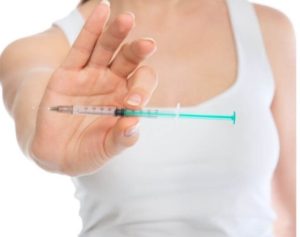Video - How to give yourself a subcutaneous injection

Are you nervous about giving yourself an injection? That’s normal. It really is quick, easy, and painless. Just click the link to watch the video.
Preparing for a subcutaneous injection
The location of injection is important for subcutaneous injections. The drug needs to be injected into the fatty tissue just below the skin. Some areas of the body have a more easily accessible layer of tissue, where a needle injected under the skin will not hit muscle, bone, or blood vessels.
The most common injection sites are:
• Abdomen: at or under the level of the belly button, about two inches away from the navel
• Arm: back or side of the upper arm
• Thigh: front of the thigh
How to administer a subcutaneous injection
1. Wash your hands.
2. Gather supplies.
• Needle and syringe
• Medication
• alcohol pads
• gauze
• puncture-resistant container to discard the used needles and syringe – you can use a 2-liter soda bottle or a laundry detergent bottle. Do not dispose of needles in the trash.
3. Clean and inspect the injection site. Before injecting medication, inspect your skin to make sure there’s no bruising, burns, swelling, hardness, or irritation in the area. Alternate injection sites to prevent damage to an area with repeated injections. Then you should clean the skin with an alcohol swab. Let the alcohol dry thoroughly before doing the injection.
4. Prepare the syringe with medication. Before withdrawing medication from a vial and injecting yourself or someone else, make sure you’re using the correct medication, at the correct dose, at the correct time, and in the right manner. Use a new needle and syringe with every injection.
Remove the cap from the vial. The rubber stopper should be cleaned with an alcohol swab.
Draw air into the syringe. Draw back the plunger to fill the syringe with air up to the dose that you’ll be injecting. This makes it easier to draw the medication into the syringe.
Insert air into the vial. Remove the cap from the needle and push the needle through the rubber stopper at the top of the vial. Inject all the air into the vial. Do not touch the needle.
Withdraw the medication. Turn the vial and syringe upside down so the needle points upward. Then pull back on the plunger to withdraw the correct amount of medication.
Remove any air bubbles. Tap the syringe to push any bubbles to the top and gently depress the plunger to push the air bubbles out.
5. Inject the medication.
Pinch your skin. Take a big pinch of skin between your thumb and index finger and hold it. (Your thumb and forefinger should be about an inch and a half apart.) This pulls the fatty tissue away from the muscle and makes the injection easier.
Inject the needle. Inject the needle into the pinched skin at a 90-degree angle. You should do this quickly, but without great force. If you have very little fat on your body, you may need to inject the needle at a 45-degree angle to the skin.
Insert the medication. Slowly push the plunger to inject the medication. You should inject the entire amount of medication.
Withdraw the needle. Let go of the pinched skin and withdraw the needle. Discard the used needle in a puncture-resistant sharp’s container.
Apply pressure to the site. Use gauze to apply light pressure to the injection site. If there’s any bleeding, it should be very minor. You may notice a little bruising later. This is common and nothing to be concerned about.
Risks with subcutaneous injection
Subcutaneous injections are very safe and complications are rare. Occasionally there is minor soreness or bruising that resolves quickly on its own. As with any injection procedure, infection at the site of injection is a possibility. Signs of infection at the injection site include:
• pain
• redness
• swelling
• warmth or drainage
These symptoms should be reported to your provider immediately.
